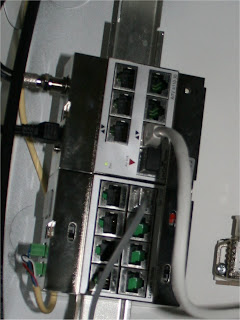The power supply must be wired in by a licensed electrician. The mains power feeds into a small transformer, which then connects to a small distribution box. The picture below shows the transformer installed into the cabinet, and the small distribution block.

The picture below shows the power distribution block and the power leads before installation into the cabinet:

The cabinet has some holes in the side to allow you to screw it onto some studs inside a wall, and there are holes in the back if you want to mount it as a surface mount cabinet on a wall. There are also some knock out panels so you can choose where you want to feed your wires in.
Our cabinet is installed inside an empty bulkhead, and the cabinet is screwed to a stud on the side, and a noggin on the bottom. The space in the bulkhead is quite confined for taking photos, however you can sort of see it in the picture below:

The initial requirement was to have TV to one point, and broadband connection to the home office. In the picture above you can see that on the right of the box there are two cables plugged in - the top grey cable connects a wall outlet to the TV/Video module. The blue cable connects a wall outlet to an ethernet port on our ADSL modem/router, which is out of the picture.
The ADSL modem/router receives the phone line from the telephone module which is one of the silver components installed on the left side of the box.
The picture below shows a photo of the component currently installed in the box:
 The top module is the TV/Video distribution component - it's an active component requiring power and you can see the silver connector one the coax cable from the TV antenna, and the black power lead. You can see the grey patch cable which is referred to above.
The top module is the TV/Video distribution component - it's an active component requiring power and you can see the silver connector one the coax cable from the TV antenna, and the black power lead. You can see the grey patch cable which is referred to above.The module below id the telephone distribution component. On the left (the green connectors) you can see the cream telephone cable connected. Elsrwhere in the house I have an ADSL splitter installed which provides ADSL on the red and black wires, and telephone on the white and blue wires. The telephone component allows configuration via some switches so that (in this case) I can ADSL on 4 ports, and telephone on 4 ports. These can be patched across to any wall outlet which needs them. I may change the configuration soon as I really only need the ADSL signal on one port, which is connected to the modem. You can see the grey wire which is running to my modem.
I hope this lot makes some sense! Now to connect more things!




No comments:
Post a Comment